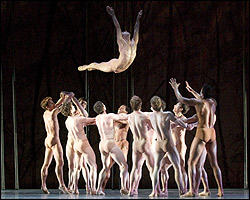Although it might be heresy to suggest, you could listen to all of the ballets on Pacific Northwest Ballet’s current program (through Sun., Feb. 13; McCaw Hall, 206-292-ARTS) with your eyes shut and still understand much of what is going on. Firebird, Apollo, and Rite of Spring were all composed by Igor Stravinsky for Serge Diaghilev’s early 20th-century Ballet Russe to follow a particular scenario, and whether you see them with their original choreography or with new versions of the dance, the music still tells their stories.
Firebird is the oldest of the three, and the most self-consciously Russian, based on a folktale about a magical bird that vanquishes an evil sorcerer and unites a pair of young lovers. The original choreography by Mikhail Fokine focused on the bird. Kent Stowell’s version for PNB places more emphasis on the young couple, reassigning sections of the music so that they dance to the Firebird’s signature lullaby. After establishing her power in the opening variation and pas de deux, the magical bird—given fiercely detailed performances by Kaori Nakamura on Thursday and Carrie Imler on Friday—finishes off the sorcerer quickly with a series of fast turns and has very little left to do. Despite the wealth of miniature Russian cathedrals and glittering headdresses brought on for the final wedding processional, the end of the ballet is so kinetically subdued that it feels anticlimactic.
George Balanchine claimed that choreographing Apollo in 1928 was a pivotal experience, encouraging him to choose movement both selectively and adventurously, and the ballet does have an austerely radical feeling even today. The story, concerning the birth and education of the young god, reaches back further in time, and the style of the ballet looks further forward to Balanchine’s streamlining of classical technique. On Friday, Jeffrey Stanton’s Apollo took his schooling very seriously, concentrating on the skills he would need to drive his chariot across the sky, while Louise Nadeau was a flirty Terpsichore, as if she thought he needed to lighten up. On Thursday, Stanko Milov’s sun god started out as a young Elvis, reveling in playing his mandolin and basking in the attention of the muses. Patricia Barker was an excellent foil as his Terpsichore, her coolness anchoring Milov’s impulsiveness.
Rite of Spring not only tells a story but has had many stories told about it and about its scandalous premiere in 1913. In retrospect, it has been seen as foreshadowing the chaos of World War I and the radical social changes that took place after that conflict; initially, it just shook everyone up, whether they loved it or thought it was an abomination. Vaslav Nijinsky’s original choreography, with its in-turned legs and simple, blocky movement, was everything that most people thought ballet was not, causing as much of a scandal as the music itself. Perhaps because of this volatile beginning, the score has drawn many choreographers to it, creating everything from meticulous enactments of the virgin sacrifice in the original to a tongue-in-cheek variation of a B-rated gangster film.
Here, Glen Tetley’s 1974 version of the work employs his visceral combination of ballet and modern dance, grafting the highly articulate torso of Martha Graham’s technique onto the amplitude of ballet-trained hips and legs. The raw momentum of the score feeds this physicality—rather than illustrating its fiendishly complex rhythmic structures, the dance rides on its harmonic dissonance. The ballet is an endurance contest for all the performers, but especially for “the Chosen One,” who suffers a punishing series of jumping falls—arching in the air like the Winged Victory only to come crashing down—that would stymie even a break-dancer. Jonathan Porretta usually has energy to spare, but in the spirit of the story’s ritual sacrifice, he had the audience gasping as he almost danced himself to death.








